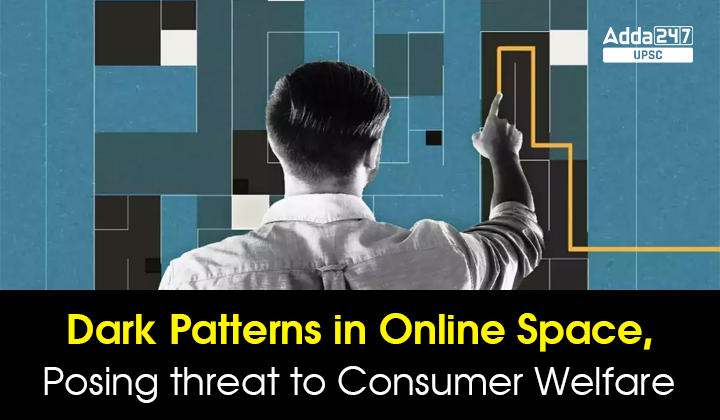Table of Contents
Dark Patterns in Online Space: Dark patterns refer to deceptive user interface design practices used on websites, applications, and other digital platforms to manipulate users’ behavior or choices. These patterns often exploit cognitive biases or take advantage of users’ limited attention or understanding. Dark Patterns in Online Space is important for UPSC Prelims Exam and UPSC Mains Exam (GS Paper 2- Various Challenges in Governance and measures taken to ensure safe online space for consumers and citizens).
Dark Patterns in Online Space in News
Recently, the Department of Consumer Affairs (DoCA) and the Advertising Standards Council of India (ASCI) organized an interactive consultation in Mumbai regarding “Dark Patterns.” The session on “Dark Patterns” was led by Shri Rohit Kumar Singh, Secretary of the Department of Consumer Affairs.
Session on Dark Patterns in Online Space
The rising prevalence of these deceptive practices, which encroach upon consumer rights, has prompted the collaborative initiative between the Department of Consumer Affairs (DoCA) and the Advertising Standards Council of India (ASCI).
- During the consultation, a wide range of self-regulatory measures were deliberated upon, targeting various sectors such as online shopping, e-ticketing, restaurants, and travel, with the aim of countering dark patterns.
- These measures encompassed actions such as prohibiting certain types of dark patterns, promoting consumer-friendly digital choice architecture, and empowering regulatory bodies.
- It was emphasized that these measures would contribute to a more transparent and consumer-centric digital environment.
- The deliberations concluded with a firm commitment to further investigate strategies to combat deceptive practices in the online realm and safeguard the interests of consumers.
- It was unanimously agreed upon that the industry, in collaboration with all stakeholders, should establish a self-regulatory framework that encompasses all sectors.
- This pivotal milestone signifies significant progress in tackling the challenges presented by dark patterns.
Stakeholder Consultation on Dark Patterns
The stakeholder consultation witnessed the participation of numerous industry stakeholders and top executives from approximately 30 platforms and organizations.
- Prominent names among the attendees included Flipkart, Zomato, Amazon, Meta, Google, MakeMyTrip, Yatra, Snapdeal, Uber, Ola, Big Basket, Meesho, Pharmeasy, Tata 1mg, and Shiprocket.
- Additionally, industry associations such as the Retailers Association of India, NASSCOM, ONDC, and legal firm Khaitan & Co. were also present during the event.
What are Dark Patterns in Online Space?
Dark patterns encompass a wide range of manipulative practices such as drip pricing, disguised advertising, bait and click, choice manipulation, false urgency and privacy concerns.
- Deceptive patterns that manipulate consumer choice and impede their right to be well informed constitute unfair practices that are prohibited under the Consumer Protection Act 2019.
- The presence of dark patterns in the digital landscape poses a substantial risk to consumers, as they are deliberately designed to undermine user autonomy, decision-making, and freedom of choice.
- These manipulative tactics can result in unintended purchases, addictive behavior, excessive usage, and violations of privacy.
Types of Dark Patterns
Some major types of Dark Patterns-
- Urgency:This tactic creates a sense of urgency or scarcity to pressure consumers into making a purchase or taking an action.
- Basket Sneaking:Websites or apps use dark patterns to add additional products or services to the shopping cart without user consent.
- Confirm Shaming: It involves guilt as a way to make consumers adhere. It criticizes or attack consumers for not conforming to a particular belief or viewpoint.
- Forced Action: This involves forcing consumers into taking an action they may not want to take, such as signing up for a service in order to access content.
- Nagging:It refers to persistent, repetitive and annoyingly constant criticism, complaints, requests for action.
- Subscription Traps: This tactic makes it easy for consumers to sign up for a service but difficult for them to cancel it, often by hiding the cancellation option or requiring multiple steps.
- Interface Interference: This tactic involves making it difficult for consumers to take certain actions, such as canceling a subscription or deleting an account.
- Bait and Switch: This involves advertising one product or service but delivering another, often of lower quality.
- Hidden Costs: This tactic involves hiding additional costs from consumers until they are already committed to making a purchase.
- Disguised Ads: Disguised ads are advertisements that are designed to look like other types of content, such as news articles or user-generated content.
Way Forward
The implementation of industry self-regulation can be instrumental in tackling this issue. Online platforms have the opportunity to create ethical design principles that discourage the utilization of dark patterns.
- By promoting responsible design practices and conducting independent assessments, platforms can effectively identify and address any instances of dark patterns.
- Enabling users with tools and resources to make informed decisions online represents an additional possible solution.
- This may involve the development of browser extensions, apps, or plugins that can identify and prevent dark patterns, as well as platforms offering more transparent and easily accessible settings and privacy options.
Conference on Consumer-Centric Approaches for E-cooking Transition
| Follow US |
| UPSC Govt Jobs UPSC Current Affairs UPSC Judiciary PCS Download Adda 247 App here to get the latest updates |



 TSPSC Group 1 Question Paper 2024, Downl...
TSPSC Group 1 Question Paper 2024, Downl...
 TSPSC Group 1 Answer key 2024 Out, Downl...
TSPSC Group 1 Answer key 2024 Out, Downl...
 UPSC Prelims 2024 Question Paper, Downlo...
UPSC Prelims 2024 Question Paper, Downlo...
